Development of a Drought Monitoring System for Winter Wheat in the Huang-Huai-Hai Region, China, Utilizing a Machine Learning–Physical Process Hybrid Model
Abstract
1. Introduction
2. Materials and Methods
2.1. Study Area
2.2. Data
2.2.1. Meteorological Data
2.2.2. Soil Moisture Observations Data
2.2.3. Soil Physical Properties Data
2.2.4. Phenological Observations Data
2.2.5. Remote Sensing Data
2.3. Methods
2.3.1. Variable Selection and Data Treatment
2.3.2. Development of Pre-Sowing Soil Moisture Estimation Model
2.3.3. Model Evaluation Metrics
2.3.4. The Soil Moisture Anomaly Percentage Index
2.3.5. Development of the ML–Physical Process Hybrid Drought Monitoring System
3. Result
3.1. Construction of Pre-Sowing Soil Moisture Estimation Model
3.1.1. Preliminary Selection of Model Architecture
3.1.2. Ranking the Importance of Input Features
3.1.3. Determination of Model Hyperparameters
3.1.4. Model Validation and Performance Analysis
3.2. Assessment of the Efficacy of the Hybrid Drought Monitoring System
3.3. Temporal and Spatial Characteristics of Drought in Winter Wheat
4. Discussion
4.1. Estimation Model for Pre-Sowing Soil Moisture Considering Preceding Effects of Multi-Source Data
4.2. ML-Physics Hybrid Technique Provides Valuable Insight into Soil Moisture Modeling
4.3. Limitations and Developments
5. Conclusions
Author Contributions
Funding
Data Availability Statement
Conflicts of Interest
References
- Ma, Q.; Li, Y.; Liu, F.; Feng, H.; Biswas, A.; Zhang, Q. SPEI and multi-threshold run theory based drought analysis using multi-source products in China. J. Hydrol. 2023, 616, 128737. [Google Scholar] [CrossRef]
- Zhang, Y.; Wang, P.; Chen, Y.; Yang, J.; Wu, D.; Ma, Y.; Huo, Z.; Liu, S. Daily dynamic thresholds of different agricultural drought grades for summer maize based on the Vegetation Water Index. J. Hydrol. 2023, 625, 130070. [Google Scholar] [CrossRef]
- IPCC. Climate Change 2021—The Physical Science Basis: Working Group I Contribution to the Sixth Assessment Report of the Intergovernmental Panel on Climate Change; Cambridge University Press: Cambridge, UK, 2023.
- Wang, R.; Zhao, H.; Qi, Y.; Zhao, F.; Chen, F.; Ding, W.; Jiang, J.; Zhang, K.; Wang, H. Onset and severity thresholds of drought impacts on wheat. Agric. Water Manag. 2023, 281, 108259. [Google Scholar] [CrossRef]
- Xu, Y.; Zhang, X.; Hao, Z.; Hao, F.; Li, C. Projections of future meteorological droughts in China under CMIP6 from a three-dimensional perspective. Agric. Water Manag. 2021, 252, 106849. [Google Scholar] [CrossRef]
- Markonis, Y.; Kumar, R.; Hanel, M.; Rakovec, O.; Máca, P.; AghaKouchak, A. The rise of compound warm-season droughts in Europe. Sci. Adv. 2021, 7, eabb9668. [Google Scholar] [CrossRef] [PubMed]
- Zhou, S.; Zhang, Y.; Park Williams, A.; Gentine, P. Projected increases in intensity, frequency, and terrestrial carbon costs of compound drought and aridity events. Sci. Adv. 2019, 5, eaau5740. [Google Scholar] [CrossRef] [PubMed]
- Zeng, Z.; Wu, W.; Li, Y.; Huang, C.; Zhang, X.; Peñuelas, J.; Zhang, Y.; Gentine, P.; Li, Z.; Wang, X.; et al. Increasing meteorological drought under climate change reduces terrestrial ecosystem productivity and carbon storage. One Earth 2023, 6, 1326–1339. [Google Scholar] [CrossRef]
- Kabato, W.; Getnet, G.T.; Sinore, T.; Nemeth, A.; Molnár, Z. Towards Climate-Smart Agriculture: Strategies for Sustainable Agricultural Production, Food Security, and Greenhouse Gas Reduction. Agronomy 2025, 15, 565. [Google Scholar] [CrossRef]
- Zhang, B.; Wang, S.; Slater, L. Anthropogenic climate change doubled the frequency of compound drought and heatwaves in low-income regions. Commun. Earth Environ. 2024, 5, 715. [Google Scholar] [CrossRef]
- Huang, H.; Huang, J.; Li, X.; Zhuo, W.; Wu, Y.; Niu, Q.; Su, W.; Yuan, W. A dataset of winter wheat aboveground biomass in China during 2007–2015 based on data assimilation. Sci. Data 2022, 9, 200. [Google Scholar] [CrossRef]
- Shi, W.; Wang, M.; Tao, F.; Xu, X.; Deng, X.; Liu, L.; Kong, X.; Zuo, L.; Lei, M.; Shi, X.; et al. Wheat redistribution in Huang-Huai-Hai, China, could reduce groundwater depletion and environmental footprints without compromising production. Commun. Earth Environ. 2024, 5, 380. [Google Scholar] [CrossRef]
- Zhao, J.; Yang, J.; Huang, R.; Xie, H.; Qin, X.; Hu, Y. Estimating evapotranspiration and drought dynamics of winter wheat under climate change: A case study in Huang-Huai-Hai region, China. Sci. Total Environ. 2024, 949, 175114. [Google Scholar] [CrossRef] [PubMed]
- Wu, X.; Wang, P.; Huo, Z.; Wu, D.; Yang, J. Crop Drought Identification Index for winter wheat based on evapotranspiration in the Huang-Huai-Hai Plain, China. Agric. Ecosyst. Environ. 2018, 263, 18–30. [Google Scholar] [CrossRef]
- Wu, J.; Wang, N.; Xing, X.; Ma, X. Loss of Net primary production of seasonal winter wheat due to multiple drought types in the main Grain-Producing area of China. J. Hydrol. 2023, 625, 130093. [Google Scholar] [CrossRef]
- Yang, C.; Liu, C.; Liu, Y.; Gao, Y.; Xing, X.; Ma, X. Prediction of drought trigger thresholds for future winter wheat yield losses in China based on the DSSAT-CERES-Wheat model and Copula conditional probabilities. Agric. Water Manag. 2024, 299, 108881. [Google Scholar] [CrossRef]
- Yao, N.; Li, L.; Feng, P.; Feng, H.; Li Liu, D.; Liu, Y.; Jiang, K.; Hu, X.; Li, Y. Projections of drought characteristics in China based on a standardized precipitation and evapotranspiration index and multiple GCMs. Sci. Total Environ. 2020, 704, 135245. [Google Scholar] [CrossRef]
- Zhao, T.; Dai, A. Uncertainties in historical changes and future projections of drought. Part II: Model-simulated historical and future drought changes. Clim. Change 2017, 144, 535–548. [Google Scholar] [CrossRef]
- Cai, Y.; Yao, C.; Wu, P.; Zhang, L.; Zhu, D.; Chen, J.; Du, Y. Effectiveness of a subsurface irrigation system with ceramic emitters under low-pressure conditions. Agric. Water Manag. 2021, 243, 106390. [Google Scholar] [CrossRef]
- Liu, J.; Si, Z.; Li, S.; Kader Mounkaila Hamani, A.; Zhang, Y.; Wu, L.; Gao, Y.; Duan, A. Variations in water sources used by winter wheat across distinct rainfall years in the North China Plain. J. Hydrol. 2023, 618, 129186. [Google Scholar] [CrossRef]
- Wang, C.; Ye, J.; Zhai, Y.; Kurexi, W.; Xing, D.; Feng, G.; Zhang, Q.; Zhang, Z. Dynamics of Moistube discharge, soil-water redistribution and wetting morphology in response to regulated working pressure heads. Agric. Water Manag. 2023, 282, 108285. [Google Scholar] [CrossRef]
- Zhang, Y.; Hao, Z.; Feng, S.; Zhang, X.; Xu, Y.; Hao, F. Agricultural drought prediction in China based on drought propagation and large-scale drivers. Agric. Water Manag. 2021, 255, 107028. [Google Scholar] [CrossRef]
- Vicente-Serrano, S.M.; Beguería, S.; López-Moreno, J.I. A Multiscalar Drought Index Sensitive to Global Warming: The Standardized Precipitation Evapotranspiration Index. J. Clim. 2010, 23, 1696–1718. [Google Scholar] [CrossRef]
- McKee, T.B.; Doesken, N.J.; Kleist, J. The relationship of drought frequency and duration to time scales. In Proceedings of the 8th Conference on Applied Climatology, Anaheim, CA, USA, 17–22 January 1993; pp. 179–183. [Google Scholar]
- Mi, Q.; Ren, C.; Wang, Y.; Gao, X.; Liu, L.; Li, Y. A robust ensemble drought index: Construction and assessment. Nat. Hazard 2023, 116, 1139–1159. [Google Scholar] [CrossRef]
- Yang, B.; Cui, Q.; Meng, Y.; Zhang, Z.; Hong, Z.; Hu, F.; Li, J.; Tao, C.; Wang, Z.; Zhang, W. Combined multivariate drought index for drought assessment in China from 2003 to 2020. Agric. Water Manag. 2023, 281, 108241. [Google Scholar] [CrossRef]
- Wu, J.; Gu, Y.; Sun, K.; Wang, N.; Shen, H.; Wang, Y.; Ma, X. Correlation of climate change and human activities with agricultural drought and its impact on the net primary production of winter wheat. J. Hydrol. 2023, 620, 129504. [Google Scholar] [CrossRef]
- Ajaz, A.; Taghvaeian, S.; Lollato, R.; Alderman, P.D.; Gowda, P.H. Gridded drought response assessment of winter wheat in Oklahoma using big data and AquaCrop-OS. Sci. Total Environ. 2025, 959, 178206. [Google Scholar] [CrossRef] [PubMed]
- Jin, N.; Shi, Y.; Niu, W.; He, L. Spatial and temporal patterns of agricultural drought in China during 1960–2020 characterized by use of the crop water deficit Abnormal Index. J. Hydrol. 2023, 627, 130454. [Google Scholar] [CrossRef]
- Wang, A.; Gao, X.; Zhou, Z.; Siddique, K.H.M.; Yang, H.; Wang, J.; Zhang, S.; Zhao, X. A novel index for vegetation drought assessment based on plant water metabolism and balance under vegetation restoration on the Loess Plateau. Sci. Total Environ. 2024, 918, 170549. [Google Scholar] [CrossRef] [PubMed]
- Fu, Z.; Ciais, P.; Prentice, I.C.; Gentine, P.; Makowski, D.; Bastos, A.; Luo, X.; Green, J.K.; Stoy, P.C.; Yang, H. Atmospheric dryness reduces photosynthesis along a large range of soil water deficits. Nat. Commun. 2022, 13, 989. [Google Scholar] [CrossRef]
- Kannenberg, S.A.; Anderegg, W.R.L.; Barnes, M.L.; Dannenberg, M.P.; Knapp, A.K. Dominant role of soil moisture in mediating carbon and water fluxes in dryland ecosystems. Nat. Geosci. 2024, 17, 38–43. [Google Scholar] [CrossRef]
- Li, M.; Wu, P.; Ma, Z.; Lv, M.; Yang, Q. Changes in soil moisture persistence in China over the past 40 years under a warming climate. J. Clim. 2020, 33, 9531–9550. [Google Scholar] [CrossRef]
- Li, M.; Wu, P.; Sexton, D.M.; Ma, Z. Potential shifts in climate zones under a future global warming scenario using soil moisture classification. Clim. Dyn. 2021, 56, 2071–2092. [Google Scholar] [CrossRef]
- Hao, Z.; AghaKouchak, A.; Nakhjiri, N.; Farahmand, A. Global integrated drought monitoring and prediction system. Sci. Data 2014, 1, 140001. [Google Scholar] [CrossRef] [PubMed]
- Martínez-Fernández, J.; González-Zamora, A.; Sánchez, N.; Gumuzzio, A.; Herrero-Jiménez, C.M. Satellite soil moisture for agricultural drought monitoring: Assessment of the SMOS derived Soil Water Deficit Index. Remote Sens. Environ. 2016, 177, 277–286. [Google Scholar] [CrossRef]
- Bergman, K.; Sabol, P.; Miskus, D. Experimental indices for monitoring global drought conditions. In Proceedings of the 13th Annual Climate Diagnostics Workshop, Cambridge, MA, USA, 31 October–4 November 1988; pp. 190–197. [Google Scholar]
- Hao, Z.; Singh, V.P.; Xia, Y. Seasonal Drought Prediction: Advances, Challenges, and Future Prospects. Rev. Geophys. 2018, 56, 108–141. [Google Scholar] [CrossRef]
- Liu, Y.; Liu, Y.; Wang, W. Inter-comparison of satellite-retrieved and Global Land Data Assimilation System-simulated soil moisture datasets for global drought analysis. Remote Sens. Environ. 2019, 220, 1–18. [Google Scholar] [CrossRef]
- Cheng, F.; Zhang, Z.; Zhuang, H.; Han, J.; Luo, Y.; Cao, J.; Zhang, L.; Zhang, J.; Xu, J.; Tao, F. ChinaCropSM1 km: A fine 1 km daily soil moisture dataset for dryland wheat and maize across China during 1993–2018. Earth Syst. Sci. Data 2023, 15, 395–409. [Google Scholar] [CrossRef]
- Wu, D.; Li, Z.; Zhu, Y.; Li, X.; Wu, Y.; Fang, S. A new agricultural drought index for monitoring the water stress of winter wheat. Agric. Water Manag. 2021, 244, 106599. [Google Scholar] [CrossRef]
- Togneri, R.; Felipe dos Santos, D.; Camponogara, G.; Nagano, H.; Custódio, G.; Prati, R.; Fernandes, S.; Kamienski, C. Soil moisture forecast for smart irrigation: The primetime for machine learning. Expert Syst. Appl. 2022, 207, 117653. [Google Scholar] [CrossRef]
- Mazzariello, A.; Albano, R.; Lacava, T.; Manfreda, S.; Sole, A. Intercomparison of recent microwave satellite soil moisture products on European ecoregions. J. Hydrol. 2023, 626, 130311. [Google Scholar] [CrossRef]
- Zeng, J.; Yuan, X.; Ji, P.; Shi, C. Effects of meteorological forcings and land surface model on soil moisture simulation over China. J. Hydrol. 2021, 603, 126978. [Google Scholar] [CrossRef]
- Zeng, J.; Yuan, X.; Ji, P. The important role of reliable land surface model simulation in high-resolution multi-source soil moisture data fusion by machine learning. J. Hydrol. 2024, 630, 130700. [Google Scholar] [CrossRef]
- Shin, Y.; Mohanty, B.P.; Kim, J.; Lee, T. Multi-model based soil moisture simulation approach under contrasting weather conditions. J. Hydrol. 2023, 617, 129112. [Google Scholar] [CrossRef]
- Zhu, Y.; Zhao, T.; Mao, W.; Ye, M.; Han, X.; Jia, B.; Yang, J. Development of flow model for partly and fully saturated soils using water balance and water table depth fluctuation analysis. J. Hydrol. 2023, 618, 129259. [Google Scholar] [CrossRef]
- Rosa, R.D.; Paredes, P.; Rodrigues, G.C.; Alves, I.; Fernando, R.M.; Pereira, L.S.; Allen, R.G. Implementing the dual crop coefficient approach in interactive software. 1. Background and computational strategy. Agric. Water Manag. 2012, 103, 8–24. [Google Scholar] [CrossRef]
- Raes, D.; Steduto, P.; Hsiao, T.C.; Fereres, E. AquaCrop—The FAO Crop Model to Simulate Yield Response to Water: II. Main Algorithms and Software Description. Agron. J. 2009, 101, 438–447. [Google Scholar] [CrossRef]
- de Wit, A.; Boogaard, H.; Fumagalli, D.; Janssen, S.; Knapen, R.; van Kraalingen, D.; Supit, I.; van der Wijngaart, R.; van Diepen, K. 25 years of the WOFOST cropping systems model. Agric. Syst. 2019, 168, 154–167. [Google Scholar] [CrossRef]
- Karandish, F.; Šimůnek, J. A comparison of numerical and machine-learning modeling of soil water content with limited input data. J. Hydrol. 2016, 543, 892–909. [Google Scholar] [CrossRef]
- Liu, Q.; Wu, Z.; Cui, N.; Jin, X.; Zhu, S.; Jiang, S.; Zhao, L.; Gong, D. Estimation of Soil Moisture Using Multi-Source Remote Sensing and Machine Learning Algorithms in Farming Land of Northern China. Remote Sens. 2023, 15, 4214. [Google Scholar] [CrossRef]
- Zhang, B.; Wu, Y.; Zhao, B.; Chanussot, J.; Hong, D.; Yao, J.; Gao, L. Progress and Challenges in Intelligent Remote Sensing Satellite Systems. IEEE J. Sel. Top. Appl. Earth Obs. Remote Sens. 2022, 15, 1814–1822. [Google Scholar] [CrossRef]
- Han, J.; Fang, S.; Mi, Q.; Wang, X.; Yu, Y.; Zhuo, W.; Peng, X. A time-continuous land surface temperature (LST) data fusion approach based on deep learning with microwave remote sensing and high-density ground truth observations. Sci. Total Environ. 2024, 914, 169992. [Google Scholar] [CrossRef] [PubMed]
- Wang, Y.; Shi, L.; Hu, Y.; Hu, X.; Song, W.; Wang, L. A comprehensive study of deep learning for soil moisture prediction. Hydrol. Earth Syst. Sci. 2024, 28, 917–943. [Google Scholar] [CrossRef]
- Teshome, F.T.; Bayabil, H.K.; Schaffer, B.; Ampatzidis, Y.; Hoogenboom, G. Improving soil moisture prediction with deep learning and machine learning models. Comput. Electron. Agric. 2024, 226, 109414. [Google Scholar] [CrossRef]
- Ivanova, I. Soil moisture forecasting from sensors-based soil moisture, weather and irrigation observations: A systematic review. Smart Agric. Technol. 2025, 10, 100692. [Google Scholar] [CrossRef]
- Logeshwaran, J.; Srivastava, D.; Kumar, K.S.; Rex, M.J.; Al-Rasheed, A.; Getahun, M.; Soufiene, B.O. Improving crop production using an agro-deep learning framework in precision agriculture. BMC Bioinf. 2024, 25, 341. [Google Scholar] [CrossRef]
- Pan, X.; Chen, J. The optimization path of agricultural industry structure and intelligent transformation by deep learning. Sci. Rep. 2024, 14, 29548. [Google Scholar] [CrossRef] [PubMed]
- Mi, Q.; Li, M.; Huo, Z.; Zhang, L.; Kong, R.; Jiang, M.; Zhang, F. Simulating the Vertical Distribution of Soil Moisture for Winter Wheat Based on a Hydrodynamic-Processes-Driven Water Balance Model in the Huang-Huai-Hai Region, China. arXiv 2024. [Google Scholar] [CrossRef]
- Zhao, J.; Peng, H.; Yang, J.; Huang, R.; Huo, Z.; Ma, Y. Response of winter wheat to different drought levels based on Google Earth Engine in the Huang-Huai-Hai Region, China. Agric. Water Manag. 2024, 292, 108662. [Google Scholar] [CrossRef]
- Zhao, L.; Li, Q.; Zhang, Y.; Wang, H.; Du, X. Normalized NDVI valley area index (NNVAI)-based framework for quantitative and timely monitoring of winter wheat frost damage on the Huang-Huai-Hai Plain, China. Agric. Ecosyst. Environ. 2020, 292, 106793. [Google Scholar] [CrossRef]
- Wu, D.; Fang, S.; Li, X.; He, D.; Zhu, Y.; Yang, Z.; Xu, J.; Wu, Y. Spatial-temporal variation in irrigation water requirement for the winter wheat-summer maize rotation system since the 1980s on the North China Plain. Agric. Water Manag. 2019, 214, 78–86. [Google Scholar] [CrossRef]
- Luo, Y.; Zhang, Z.; Chen, Y.; Li, Z.; Tao, F. ChinaCropPhen1km: A high-resolution crop phenological dataset for three staple crops in China during 2000–2015 based on leaf area index (LAI) products. Earth Syst. Sci. Data 2020, 12, 197–214. [Google Scholar] [CrossRef]
- Wu, D.; Cao, T.; Xue, H. The Study of Quality Control for Observing Data of Automatic Soil Moisture. Hans J. Soil Sci. 2016, 4, 1–10. [Google Scholar] [CrossRef]
- Shangguan, W.; Dai, Y.; Liu, B.; Zhu, A.; Duan, Q.; Wu, L.; Ji, D.; Ye, A.; Yuan, H.; Zhang, Q. A China data set of soil properties for land surface modeling. J. Adv. Model Earth. Syst. 2013, 5, 212–224. [Google Scholar] [CrossRef]
- Saxton, K.E.; Rawls, W.J. Soil water characteristic estimates by texture and organic matter for hydrologic solutions. Soil Sci. Soc. Am. J. 2006, 70, 1569–1578. [Google Scholar] [CrossRef]
- Zhang, B.; Liu, Y.; Xu, D.; Zhao, N.; Lei, B.; Rosa, R.D.; Paredes, P.; Paço, T.A.; Pereira, L.S. The dual crop coefficient approach to estimate and partitioning evapotranspiration of the winter wheat–summer maize crop sequence in North China Plain. Irrig. Sci. 2013, 31, 1303–1316. [Google Scholar] [CrossRef]
- Wu, P.; Wang, Y.; Li, Y.; Yu, H.; Shao, J.; Zhao, Z.; Qiao, Y.; Liu, C.; Liu, S.; Gao, C.; et al. Evaluating optimized irrigation strategies on crop productivity and field water utilization under micro sprinkling irrigation in typical cropping systems of the Huang-Huai-Hai Plain. Eur. J. Agron. 2024, 154, 127093. [Google Scholar] [CrossRef]
- Kendy, E.; Gérard-Marchant, P.; Todd Walter, M.; Zhang, Y.; Liu, C.; Steenhuis, T.S. A soil-water-balance approach to quantify groundwater recharge from irrigated cropland in the North China Plain. Hydrol. Process. 2003, 17, 2011–2031. [Google Scholar] [CrossRef]
- Yang, X.; Wang, G.; Chen, Y.; Sui, P.; Pacenka, S.; Steenhuis, T.S.; Siddique, K.H.M. Reduced groundwater use and increased grain production by optimized irrigation scheduling in winter wheat–summer maize double cropping system—A 16-year field study in North China Plain. Field Crops Res. 2022, 275, 108364. [Google Scholar] [CrossRef]
- Vereecken, H.; Amelung, W.; Bauke, S.L.; Bogena, H.; Brüggemann, N.; Montzka, C.; Vanderborght, J.; Bechtold, M.; Blöschl, G.; Carminati, A. Soil hydrology in the Earth system. Nat. Rev. Earth Environ. 2022, 3, 573–587. [Google Scholar] [CrossRef]
- Tenreiro, T.R.; García-Vila, M.; Gómez, J.A.; Jimenez-Berni, J.A.; Fereres, E. Water modelling approaches and opportunities to simulate spatial water variations at crop field level. Agric. Water Manag. 2020, 240, 106254. [Google Scholar] [CrossRef]
- Li, M.; Huo, Z.; Mi, Q.; Zhang, L.; Yang, J.; Zhang, F.; Kong, R.; Wang, Y.; Huo, Y. A Dynamic Monitoring Framework for Spring Low-Temperature Disasters Affecting Winter Wheat: Exploring Environmental Coercion and Mitigation Mechanisms. Agronomy 2025, 15, 337. [Google Scholar] [CrossRef]
- Zha, X.; Jia, S.; Han, Y.; Zhu, W.; Lv, A. Enhancing Soil Moisture Prediction in Drought-Prone Agricultural Regions Using Remote Sensing and Machine Learning Approaches. Remote Sens. 2025, 17, 181. [Google Scholar] [CrossRef]
- Wang, X.; Corzo, G.; Lü, H.; Zhou, S.; Mao, K.; Zhu, Y.; Duarte, S.; Liu, M.; Su, J. Sub-seasonal soil moisture anomaly forecasting using combinations of deep learning, based on the reanalysis soil moisture records. Agric. Water Manag. 2024, 295, 108772. [Google Scholar] [CrossRef]
- Ji, Y.; Li, Y.; Yao, N.; Biswas, A.; Zou, Y.; Meng, Q.; Liu, F. The lagged effect and impact of soil moisture drought on terrestrial ecosystem water use efficiency. Ecol. Indic. 2021, 133, 108349. [Google Scholar] [CrossRef]
- Xu, Z.-G.; Wu, Z.-Y.; He, H.; Guo, X.; Zhang, Y.-L. Comparison of soil moisture at different depths for drought monitoring based on improved soil moisture anomaly percentage index. Water Sci. Eng. 2021, 14, 171–183. [Google Scholar] [CrossRef]
- Li, L.; Li, H.; Liu, N.; Lu, Y.; Shao, L.; Chen, S.; Zhang, X. Water use characteristics and drought tolerant ability of different winter wheat cultivars assessed under whole growth circle and at seedling stage. Agric. Water Manag. 2024, 300, 108921. [Google Scholar] [CrossRef]
- Eitzinger, J.; Štastná, M.; Žalud, Z.; Dubrovský, M. A simulation study of the effect of soil water balance and water stress on winter wheat production under different climate change scenarios. Agric. Water Manag. 2003, 61, 195–217. [Google Scholar] [CrossRef]
- Wang, L.; Liu, X.; Liu, X.; Bao, X.; Zhang, X.; Yin, B.; Wang, W.; Wang, Y.; Zhen, W. Effects of spring limited irrigation on grain yield and root characteristics of winter wheat in groundwater-overexploitation areas in the North China Plain. Agric. Water Manag. 2024, 294, 108729. [Google Scholar] [CrossRef]
- Li, H.; Li, L.; Liu, N.; Chen, S.; Shao, L.; Sekiya, N.; Zhang, X. Root efficiency and water use regulation relating to rooting depth of winter wheat. Agric. Water Manag. 2022, 269, 107710. [Google Scholar] [CrossRef]
- Albasha, R.; Mailhol, J.-C.; Cheviron, B. Compensatory uptake functions in empirical macroscopic root water uptake models—Experimental and numerical analysis. Agric. Water Manag. 2015, 155, 22–39. [Google Scholar] [CrossRef]
- de Melo, M.L.A.; de Jong van Lier, Q. Revisiting the Feddes reduction function for modeling root water uptake and crop transpiration. J. Hydrol. 2021, 603, 126952. [Google Scholar] [CrossRef]
- Gao, Y.; Chen, J.; Wang, G.; Liu, Z.; Sun, W.; Zhang, Y.; Zhang, X. Different responses in root water uptake of summer maize to planting density and nitrogen fertilization. Front. Plant Sci. 2022, 13, 918043. [Google Scholar] [CrossRef] [PubMed]
- Cui, Y.; Jia, L. Estimation of evapotranspiration of “soil-vegetation” system with a scheme combining a dual-source model and satellite data assimilation. J. Hydrol. 2021, 603, 127145. [Google Scholar] [CrossRef]
- Allen, R.G.; Pereira, L.S.; Raes, D.; Smith, M. Crop Evapotranspiration-Guidelines for Computing Crop Water Requirements-FAO Irrigation and Drainage Paper 56; FAO: Rome, Italy, 1998; Volume 300, p. D05109. [Google Scholar]
- Wu, B.; Ma, Z.; Yan, N. Agricultural drought mitigating indices derived from the changes in drought characteristics. Remote Sens. Environ. 2020, 244, 111813. [Google Scholar] [CrossRef]
- Xu, X.; Zhang, M.; Li, J.; Liu, Z.; Zhao, Z.; Zhang, Y.; Zhou, S.; Wang, Z. Improving water use efficiency and grain yield of winter wheat by optimizing irrigations in the North China Plain. Field Crops Res. 2018, 221, 219–227. [Google Scholar] [CrossRef]
- Li, H.; Jia, B.; Wang, H.; Li, D.; Fang, Q.; He, J.; Li, R. Yield response of supplementary irrigation at the anthesis stage of winter wheat. Agric. Water Manag. 2023, 284, 108352. [Google Scholar] [CrossRef]
- China Meteorological Administration. Yearbook of Meteorological Disasters in China (2005); China Meteorological Press: Beijing, China, 2006; p. 36.
- Dong, Z.; Zhang, X.; Li, J.; Zhang, C.; Wei, T.; Yang, Z.; Cai, T.; Zhang, P.; Ding, R.; Jia, Z. Photosynthetic characteristics and grain yield of winter wheat (Triticum aestivum L.) in response to fertilizer, precipitation, and soil water storage before sowing under the ridge and furrow system: A path analysis. Agric. For. Meteorol. 2019, 272–273, 12–19. [Google Scholar] [CrossRef]
- Ren, A.; Sun, M.; Xue, L.; Deng, Y.; Wang, P.; Lei, M.; Xue, J.; Lin, W.; Yang, Z.; Gao, Z. Spatio-temporal dynamics in soil water storage reveals effects of nitrogen inputs on soil water consumption at different growth stages of winter wheat. Agric. Water Manag. 2019, 216, 379–389. [Google Scholar] [CrossRef]
- China Meteorological Administration. Yearbook of Meteorological Disasters in China (2010); China Meteorological Press: Beijing, China, 2011; p. 73.
- China Meteorological Administration. Yearbook of Meteorological Disasters in China (2011); China Meteorological Press: Beijing, China, 2012; p. 68.
- Wan, L.; Bento, V.A.; Qu, Y.; Qiu, J.; Song, H.; Zhang, R.; Wu, X.; Xu, F.; Lu, J.; Wang, Q. Drought characteristics and dominant factors across China: Insights from high-resolution daily SPEI dataset between 1979 and 2018. Sci. Total Environ. 2023, 901, 166362. [Google Scholar] [CrossRef] [PubMed]
- Chen, D.; Guo, Y.; Zhao, Y.; Zhang, J.; Liu, X.; Tong, Z.; Zhao, C. Dynamic evolution characteristics and hazard assessment of compound drought/waterlogging and low temperature events for maize. Sci. Total Environ. 2024, 946, 174427. [Google Scholar] [CrossRef] [PubMed]
- Wang, X.; Wang, H.; Si, Z.; Gao, Y.; Duan, A. Modelling responses of cotton growth and yield to pre-planting soil moisture with the CROPGRO-Cotton model for a mulched drip irrigation system in the Tarim Basin. Agric. Water Manag. 2020, 241, 106378. [Google Scholar] [CrossRef]
- Lollato, R.P.; Patrignani, A.; Ochsner, T.E.; Edwards, J.T. Prediction of Plant Available Water at Sowing for Winter Wheat in the Southern Great Plains. Agron. J. 2016, 108, 745–757. [Google Scholar] [CrossRef]
- Grassini, P.; You, J.; Hubbard, K.G.; Cassman, K.G. Soil water recharge in a semi-arid temperate climate of the Central U.S. Great Plains. Agric. Water Manag. 2010, 97, 1063–1069. [Google Scholar] [CrossRef]
- Nielsen, D.C.; Vigil, M.F. Precipitation Storage Efficiency during Fallow in Wheat-Fallow Systems. Agron. J. 2010, 102, 537–543. [Google Scholar] [CrossRef]
- Tian, Y.; Xu, Y.-P.; Wang, G. Agricultural drought prediction using climate indices based on Support Vector Regression in Xiangjiang River basin. Sci. Total Environ. 2018, 622–623, 710–720. [Google Scholar] [CrossRef] [PubMed]
- Li, S.; Zhu, P.; Song, N.; Li, C.; Wang, J. Regional Soil Moisture Estimation Leveraging Multi-Source Data Fusion and Automated Machine Learning. Remote Sens. 2025, 17, 837. [Google Scholar] [CrossRef]
- Zheng, M.; Liu, Z.; Li, J.; Xu, Z.; Sun, J. Downscaling soil moisture in regions with high soil heterogeneity: The solution based on ensemble learning with sequential and parallel learner. Sci. Total Environ. 2024, 950, 175260. [Google Scholar] [CrossRef]
- Ming, L.; Wang, Y.; Liu, G.; Meng, L.; Chen, X. Analysis of vegetation dynamics from 2001 to 2020 in China’s Ganzhou rare earth mining area using time series remote sensing and SHAP-enhanced machine learning. Ecol. Inf. 2024, 84, 102887. [Google Scholar] [CrossRef]
- Xue, C.; Ghirardelli, A.; Chen, J.; Tarolli, P. Investigating agricultural drought in Northern Italy through explainable Machine Learning: Insights from the 2022 drought. Comput. Electron. Agric. 2024, 227, 109572. [Google Scholar] [CrossRef]
- Li, L.; Dai, Y.; Wei, Z.; Shangguan, W.; Wei, N.; Zhang, Y.; Li, Q.; Li, X.-X. Enhancing Deep Learning Soil Moisture Forecasting Models by Integrating Physics-based Models. Adv. Atmos. Sci. 2024, 41, 1326–1341. [Google Scholar] [CrossRef]
- Li, H.; Zheng, L.; Lei, Y.; Li, C.; Liu, Z.; Zhang, S. Estimation of water consumption and crop water productivity of winter wheat in North China Plain using remote sensing technology. Agric. Water Manag. 2008, 95, 1271–1278. [Google Scholar] [CrossRef]
- Liao, Q.-Y.; Leng, P.; Li, Z.-L.; Labed, J. Prediction of Root-Zone Soil Moisture and Evapotranspiration in Cropland Using HYDRUS-1D Model with Different Soil Hydrodynamic Parameter Schemes. Water 2025, 17, 730. [Google Scholar] [CrossRef]
- Huang, M.; Wang, C.; Qi, W.; Zhang, Z.; Xu, H. Modelling the integrated strategies of deficit irrigation, nitrogen fertilization, and biochar addition for winter wheat by AquaCrop based on a two-year field study. Field Crops Res. 2022, 282, 108510. [Google Scholar] [CrossRef]
- Zhang, Y.; Wu, Z.; Singh, V.P.; Lin, Q.; Ning, S.; Zhou, Y.; Jin, J.; Zhou, R.; Ma, Q. Agricultural drought characteristics in a typical plain region considering irrigation, crop growth, and water demand impacts. Agric. Water Manag. 2023, 282, 108266. [Google Scholar] [CrossRef]
- Sun, P.; Ge, C.; Yao, R.; Bian, Y.; Yang, H.; Zhang, Q.; Xu, C.-Y.; Singh, V.P. Development of a nonstationary Standardized Precipitation Evapotranspiration Index (NSPEI) and its application across China. Atmos. Res. 2024, 300, 107256. [Google Scholar] [CrossRef]
- Chen, W.; Yao, R.; Sun, P.; Zhang, Q.; Singh, V.P.; Sun, S.; AghaKouchak, A.; Ge, C.; Yang, H. Drought Risk Assessment of Winter Wheat at Different Growth Stages in Huang-Huai-Hai Plain Based on Nonstationary Standardized Precipitation Evapotranspiration Index and Crop Coefficient. Remote Sens. 2024, 16, 1625. [Google Scholar] [CrossRef]

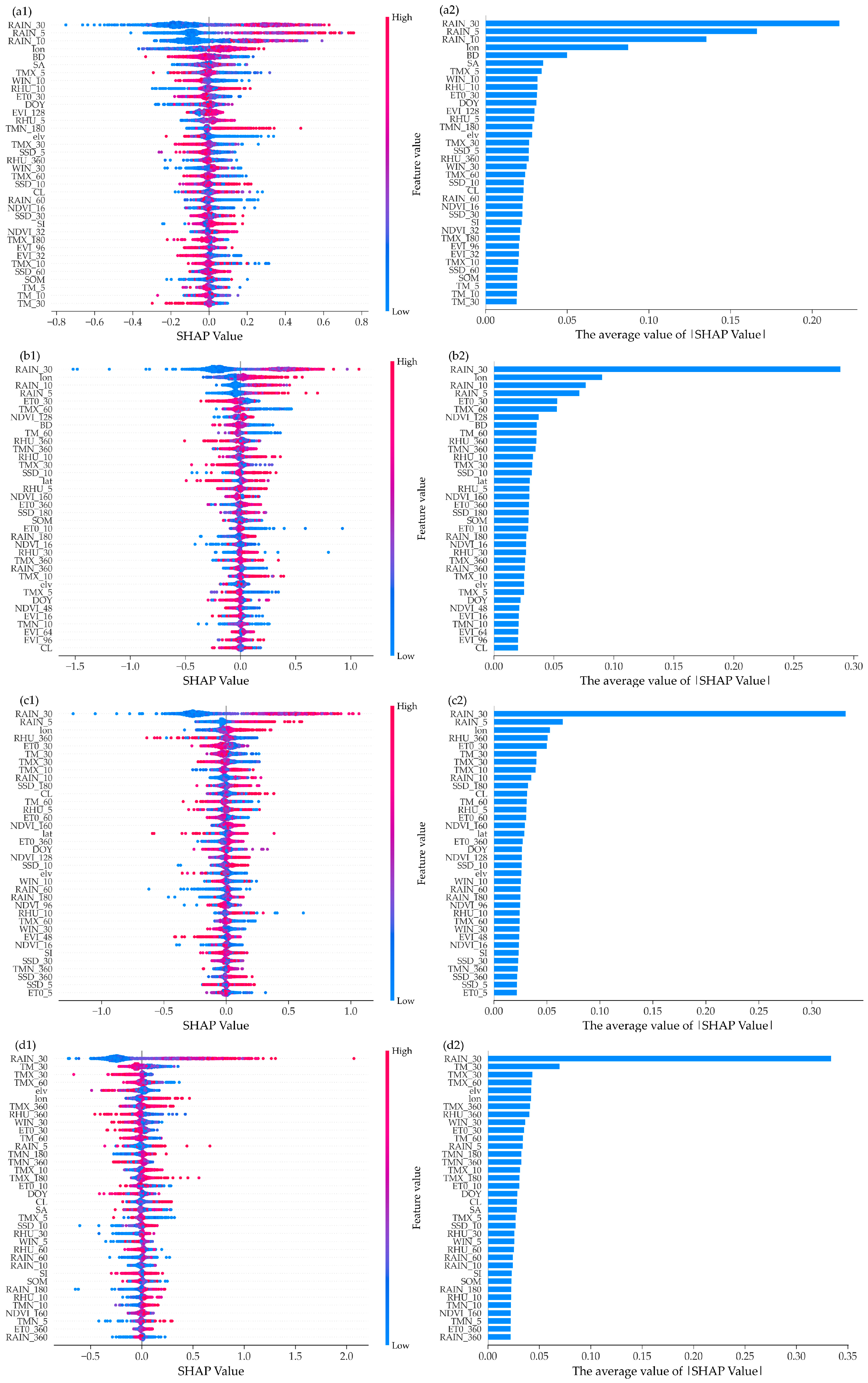
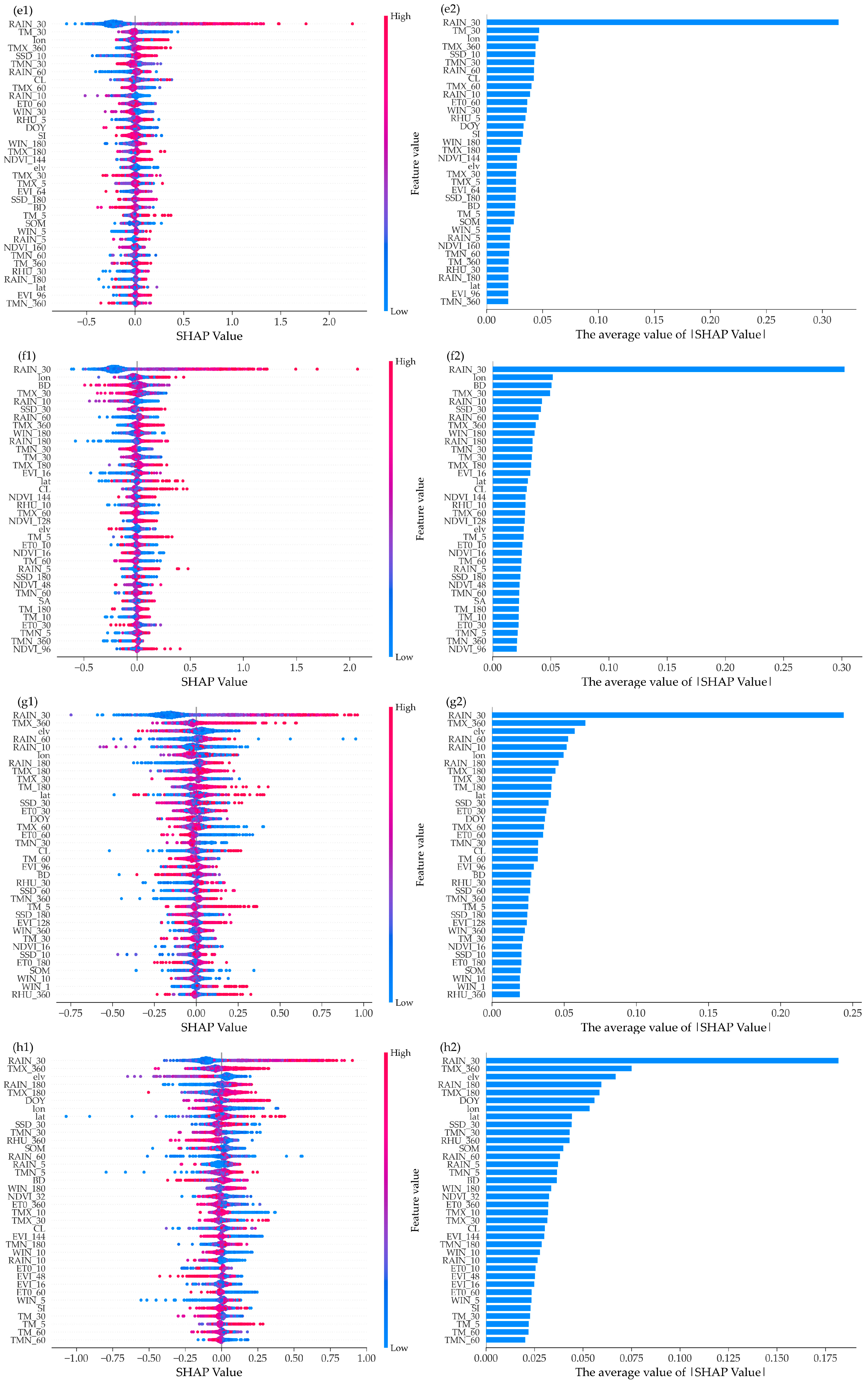

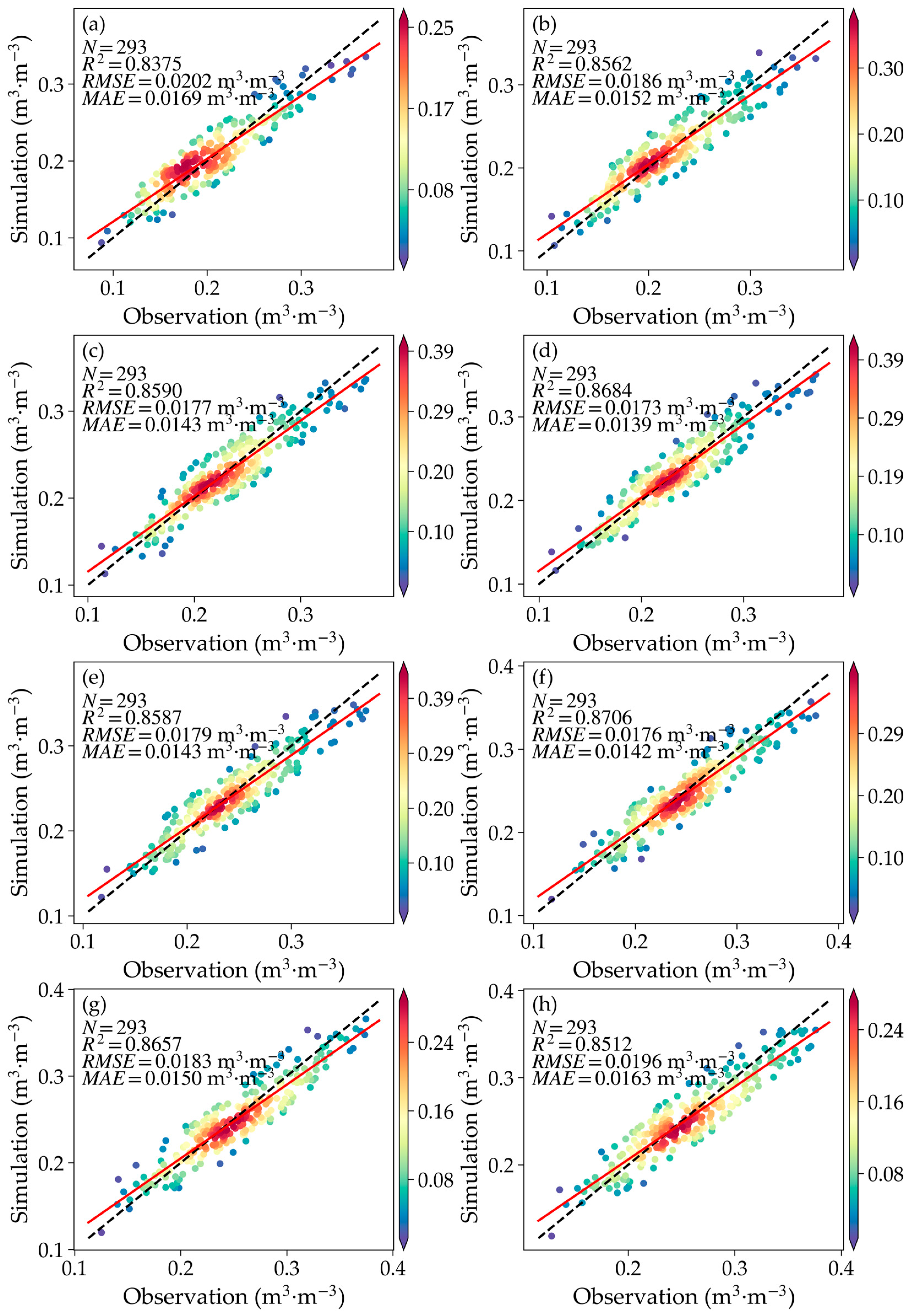
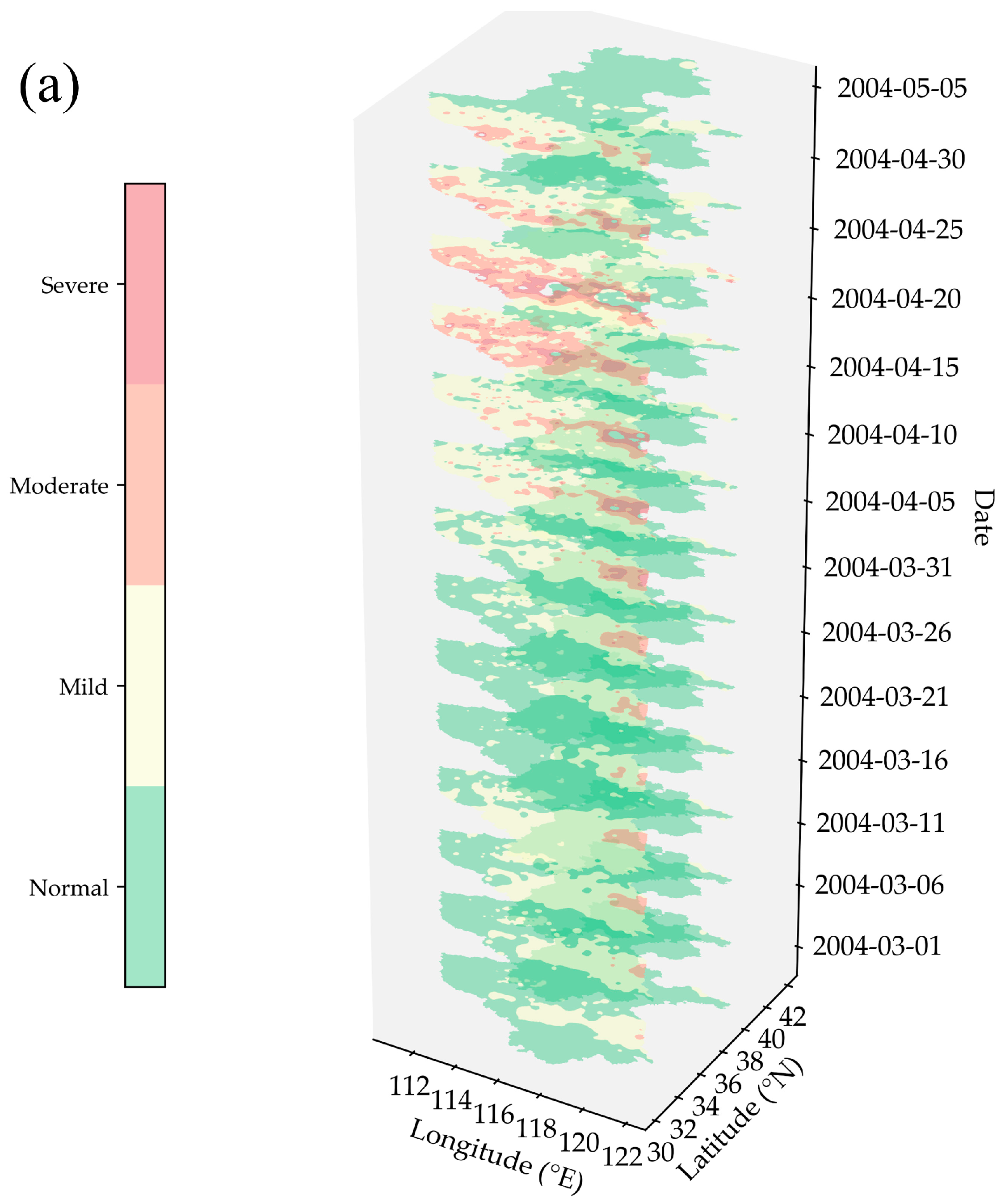
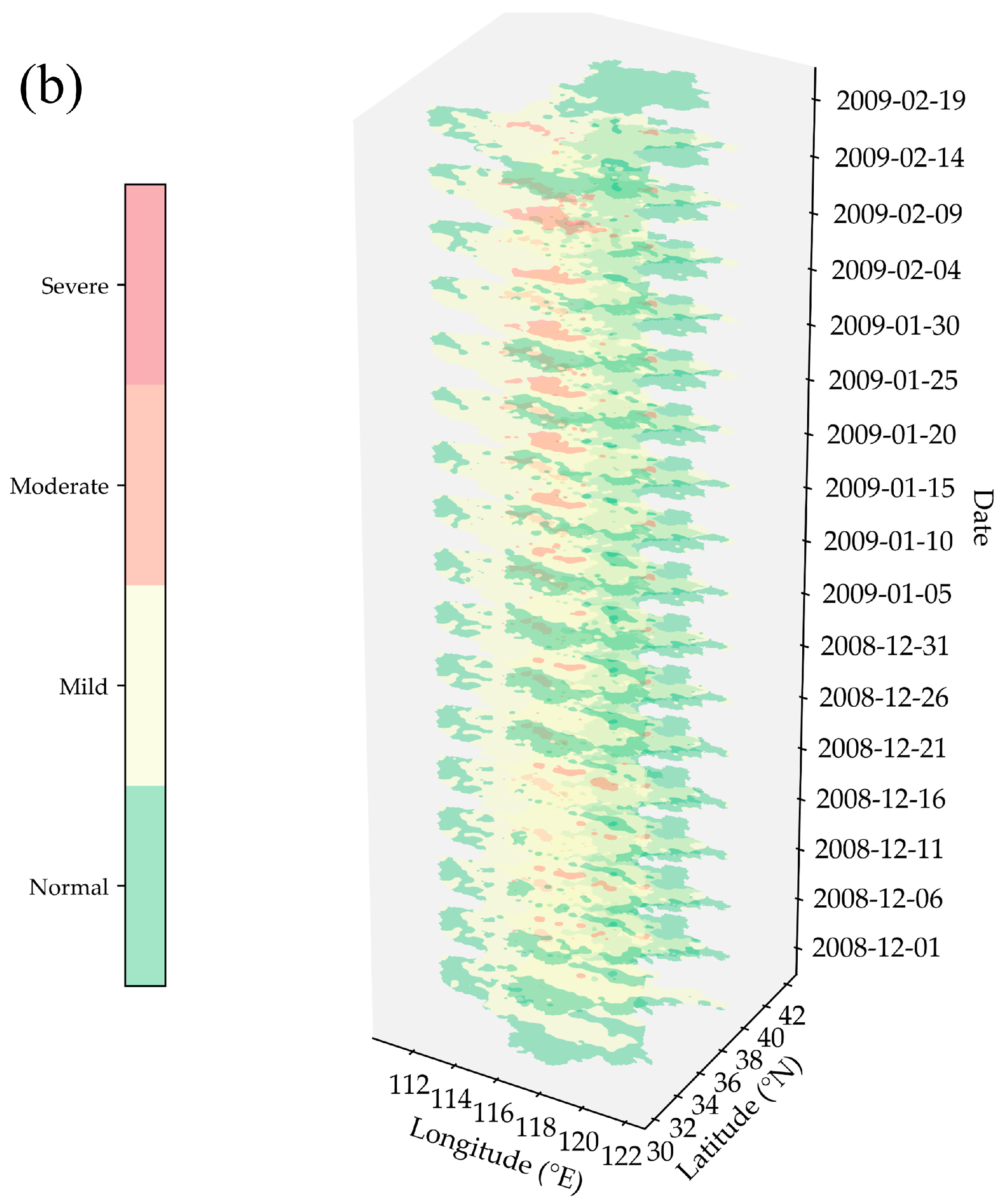
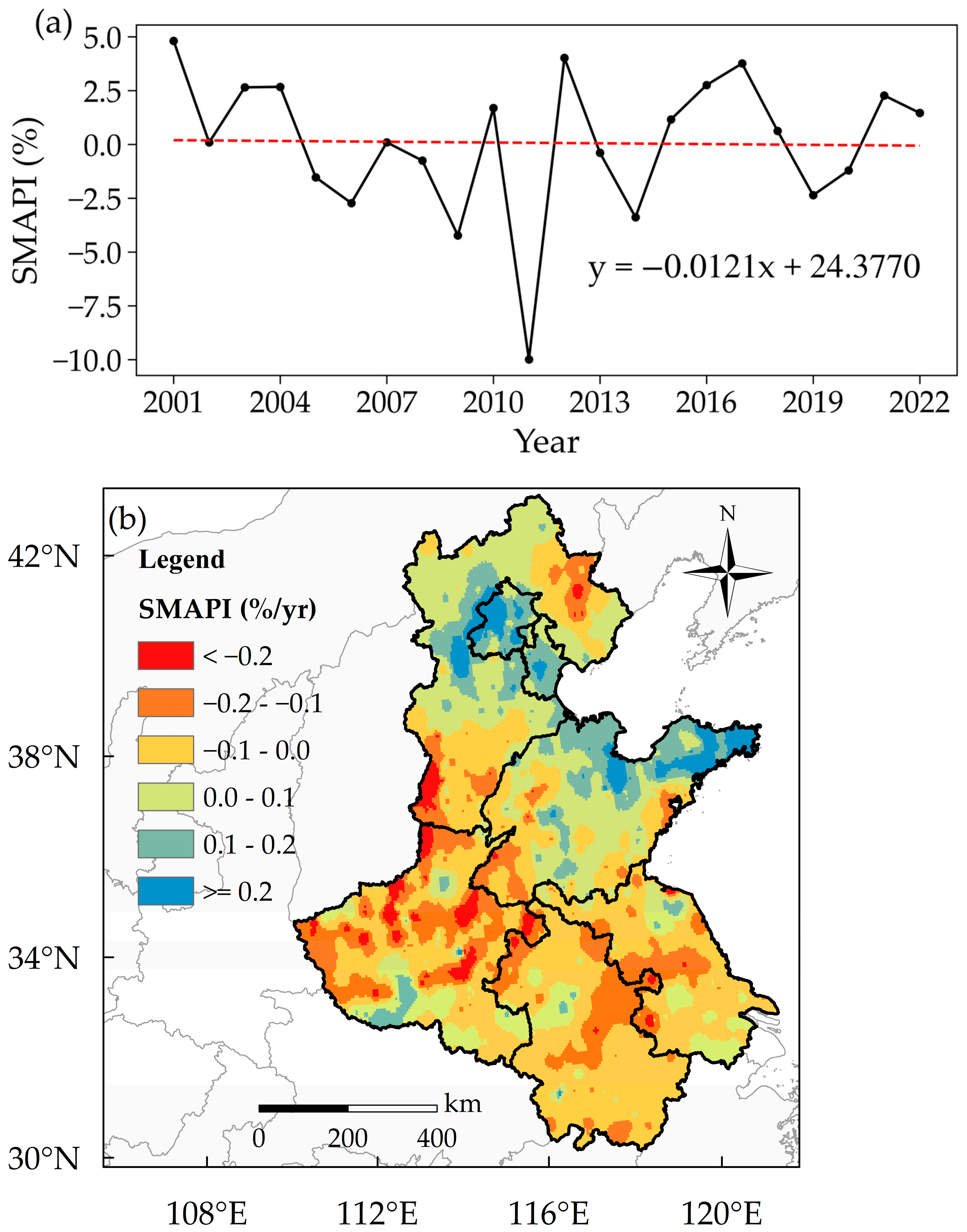
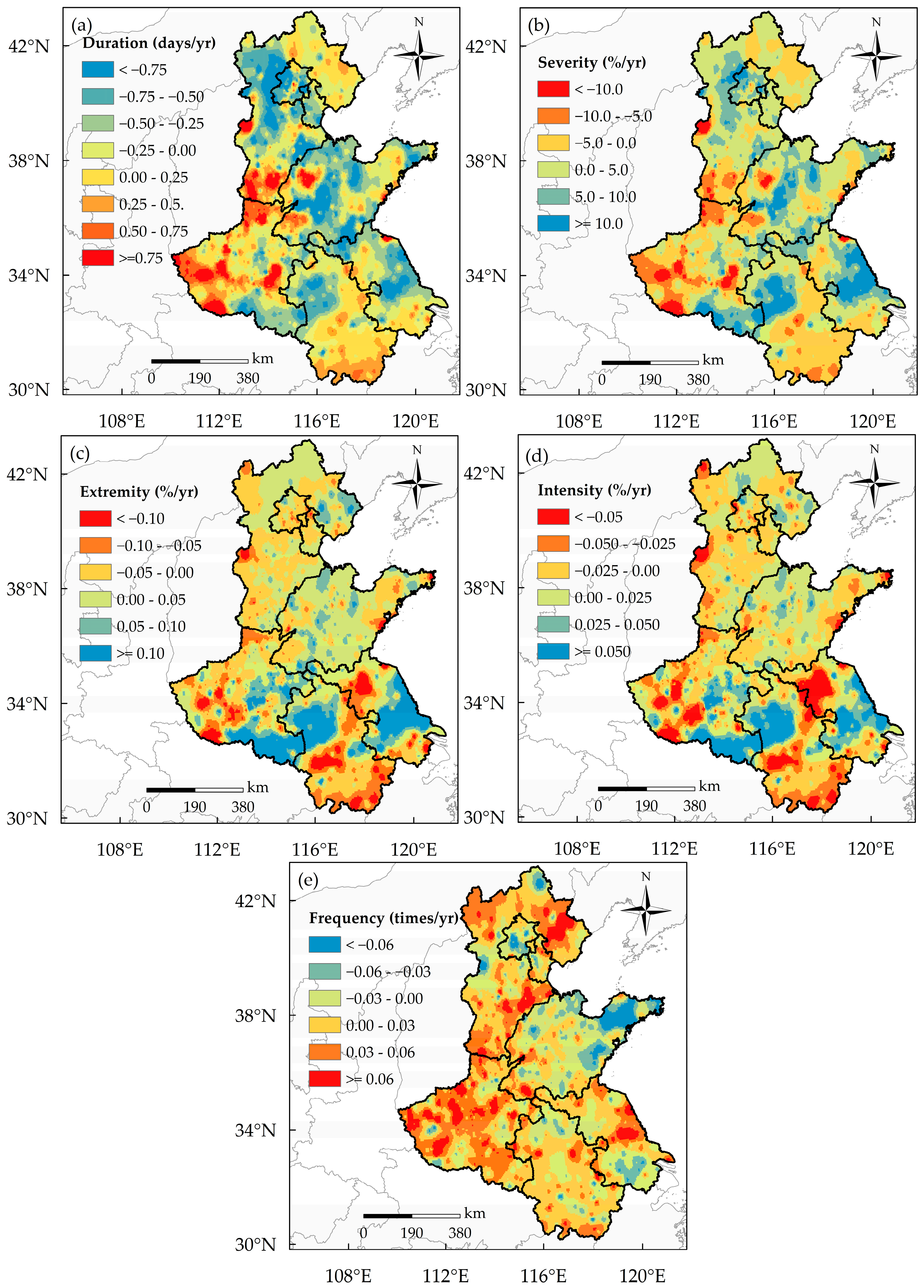
| Data Type | Variable | Data Description | Temporal Resolution | Spatial Resolution | Ante-Accumulated Days |
|---|---|---|---|---|---|
| MD | PRE | Precipitation | Daily | Station | 1, 5, 10, 30, 60, 180, and 360 days |
| ET0 | Potential evapotranspiration | Daily | Station | ||
| TN | Mean temperature | Daily | Station | ||
| TMX | Maximum temperature | Daily | Station | ||
| TMN | Minimum temperature | Daily | Station | ||
| RH | Relative humidity | Daily | Station | ||
| PRS | Atmospheric pressure | Daily | Station | ||
| WIN | Wind speed | Daily | Station | ||
| SSD | Sunshine duration | Daily | Station | ||
| PI | DOY | Sowing day of year | - | - | - |
| GI | LAT | Latitude | - | Station | - |
| LON | Longitude | - | Station | - | |
| ELV | Elevation | - | Station | - | |
| SP | CL | Soil clay content | - | Irregular | - |
| SD | Soil sand content | - | Irregular | - | |
| SI | Soil silt content | - | Irregular | ||
| SOM | Soil organic matter content | - | Irregular | - | |
| BD | Soil bulk density | - | Irregular | - | |
| RSD | NDVI | Normalized difference vegetation index | 16 days | 500 m | 16, 32, 48, 64, 96, 128, 144, and 160 days |
| EVI | Enhanced vegetation index | 16 days | 500 m |
| Category | SMAPI (%) |
|---|---|
| Drought-free | >−5.0 |
| Mild drought | −5.0 to −15.0 |
| Moderate drought | −15.0 to −20.0 |
| Severe drought | ≤−20.0 |
| ML Models | R2 | RMSE (m3·m−3) | MAE (m3·m−3) |
|---|---|---|---|
| Ridge | 0.74276 | 0.02165 | 0.01850 |
| Lasso | 0.73731 | 0.02191 | 0.01874 |
| DT | 0.71303 | 0.02291 | 0.01853 |
| KNN | 0.79490 | 0.02034 | 0.01692 |
| SVR | 0.84571 | 0.01865 | 0.01533 |
| MLP | 0.76925 | 0.02122 | 0.01761 |
| RF | 0.84755 | 0.01861 | 0.01526 |
| Bagging | 0.82425 | 0.01921 | 0.01582 |
| GdBoost | 0.83938 | 0.01899 | 0.01580 |
| AdaBoost | 0.79256 | 0.02055 | 0.01736 |
| XGBoost | 0.82089 | 0.01934 | 0.01558 |
Disclaimer/Publisher’s Note: The statements, opinions and data contained in all publications are solely those of the individual author(s) and contributor(s) and not of MDPI and/or the editor(s). MDPI and/or the editor(s) disclaim responsibility for any injury to people or property resulting from any ideas, methods, instructions or products referred to in the content. |
© 2025 by the authors. Licensee MDPI, Basel, Switzerland. This article is an open access article distributed under the terms and conditions of the Creative Commons Attribution (CC BY) license (https://creativecommons.org/licenses/by/4.0/).
Share and Cite
Mi, Q.; Huo, Z.; Li, M.; Zhang, L.; Kong, R.; Zhang, F.; Wang, Y.; Huo, Y. Development of a Drought Monitoring System for Winter Wheat in the Huang-Huai-Hai Region, China, Utilizing a Machine Learning–Physical Process Hybrid Model. Agronomy 2025, 15, 696. https://doi.org/10.3390/agronomy15030696
Mi Q, Huo Z, Li M, Zhang L, Kong R, Zhang F, Wang Y, Huo Y. Development of a Drought Monitoring System for Winter Wheat in the Huang-Huai-Hai Region, China, Utilizing a Machine Learning–Physical Process Hybrid Model. Agronomy. 2025; 15(3):696. https://doi.org/10.3390/agronomy15030696
Chicago/Turabian StyleMi, Qianchuan, Zhiguo Huo, Meixuan Li, Lei Zhang, Rui Kong, Fengyin Zhang, Yi Wang, and Yuxin Huo. 2025. "Development of a Drought Monitoring System for Winter Wheat in the Huang-Huai-Hai Region, China, Utilizing a Machine Learning–Physical Process Hybrid Model" Agronomy 15, no. 3: 696. https://doi.org/10.3390/agronomy15030696
APA StyleMi, Q., Huo, Z., Li, M., Zhang, L., Kong, R., Zhang, F., Wang, Y., & Huo, Y. (2025). Development of a Drought Monitoring System for Winter Wheat in the Huang-Huai-Hai Region, China, Utilizing a Machine Learning–Physical Process Hybrid Model. Agronomy, 15(3), 696. https://doi.org/10.3390/agronomy15030696





